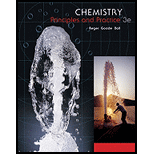
Chemistry: Principles and Practice
3rd Edition
ISBN: 9780534420123
Author: Daniel L. Reger, Scott R. Goode, David W. Ball, Edward Mercer
Publisher: Cengage Learning
expand_more
expand_more
format_list_bulleted
Question
Chapter 21, Problem 21.15QE
Interpretation Introduction
Interpretation:
Removal of fuel rods from the reactors makes it to be hazardous and the reason for this has to be explained.
Expert Solution & Answer
Want to see the full answer?
Check out a sample textbook solution
Students have asked these similar questions
Please help
(a)
21.8 Name the following compounds.
&
(b)
Br
(e)
O₂N.
(h)
H
(c)
Br
(d)
NH2
☑N
Br
H
ہیں
Ph
(g)
OMe
бл
.0-0.e
21.9 Draw a structural formula for each compound.
(a) 2,3-Dinitrotoluene
(c) Diphenylmethanol
(e) p-Nitroaniline
(b) 3-Propylanisole
(d) m-Propylphenol
(f) Pentabromobenzene
Is this the major product of this reaction?
Chapter 21 Solutions
Chemistry: Principles and Practice
Ch. 21 - Prob. 21.1QECh. 21 - Prob. 21.2QECh. 21 - Prob. 21.3QECh. 21 - Prob. 21.4QECh. 21 - Prob. 21.5QECh. 21 - Prob. 21.6QECh. 21 - Prob. 21.7QECh. 21 - Prob. 21.8QECh. 21 - Prob. 21.9QECh. 21 - Prob. 21.10QE
Ch. 21 - Prob. 21.11QECh. 21 - Prob. 21.12QECh. 21 - Prob. 21.13QECh. 21 - Prob. 21.14QECh. 21 - Prob. 21.15QECh. 21 - Prob. 21.16QECh. 21 - Prob. 21.17QECh. 21 - Prob. 21.18QECh. 21 - Prob. 21.19QECh. 21 - Prob. 21.20QECh. 21 - Prob. 21.21QECh. 21 - Prob. 21.22QECh. 21 - Prob. 21.23QECh. 21 - Prob. 21.24QECh. 21 - Prob. 21.25QECh. 21 - Prob. 21.26QECh. 21 - Prob. 21.27QECh. 21 - Prob. 21.28QECh. 21 - Prob. 21.29QECh. 21 - Prob. 21.30QECh. 21 - Prob. 21.31QECh. 21 - Prob. 21.32QECh. 21 - Prob. 21.33QECh. 21 - Prob. 21.34QECh. 21 - Prob. 21.35QECh. 21 - Prob. 21.36QECh. 21 - Prob. 21.37QECh. 21 - Prob. 21.38QECh. 21 - Prob. 21.39QECh. 21 - Prob. 21.40QECh. 21 - Prob. 21.41QECh. 21 - Prob. 21.42QECh. 21 - Prob. 21.43QECh. 21 - Prob. 21.44QECh. 21 - Prob. 21.45QECh. 21 - Prob. 21.46QECh. 21 - Prob. 21.47QECh. 21 - Prob. 21.48QECh. 21 - Prob. 21.49QECh. 21 - Prob. 21.50QECh. 21 - Prob. 21.51QECh. 21 - Prob. 21.52QECh. 21 - Prob. 21.53QECh. 21 - Prob. 21.54QECh. 21 - Prob. 21.55QECh. 21 - Prob. 21.56QECh. 21 - Prob. 21.57QECh. 21 - Prob. 21.58QECh. 21 - Prob. 21.59QECh. 21 - Prob. 21.60QECh. 21 - Prob. 21.61QECh. 21 - Prob. 21.62QECh. 21 - Prob. 21.63QECh. 21 - Prob. 21.64QECh. 21 - Prob. 21.65QE
Knowledge Booster
Similar questions
- Help me solve this problem.arrow_forwardDraw a mechanism for the following synthetic transformation including reagents and any isolable intermediates throughout the process. Please clearly indicate bond cleavage/formation using curly arrows. MeO2Carrow_forwardCHEM 310 Quiz 8 Organic Chemistry II Due: Tuesday, April 25th, at 11:59 pm. This quiz is open textbook / open notes - but you must work alone. You cannot use the internet or the solutions manual for the book. Scan in your work and record an explanation of your mechanism. You may record this any way that you like. One way would be to start an individual Zoom meeting, start recording, "share your screen" and then talk through the problem. This will be converted to an .mp4 file that you can upload into Canvas using the "record/upload media" feature. Pyridine, benzoic acid and benzene are dissolved in ethyl acetate. Design and provide a plan / flow chart for separating and isolating each of these components. Pyridine and benzene are liquids at room temperature. Benzoic acid is a solid. You have ethyl acetate, 2M NaOH, 2M HCI and anhydrous MgSO4 available, as well as all the glassware and equipment that you used in the organic lab this year. Provide accurate acid/base reactions for any…arrow_forward
- Can anyone help me solve this step by step. Thank you in advaarrow_forwardPlease draw the mechanism for this Friedel-crafts acylation reaction using arrowsarrow_forwardDraw the Fischer projection of D-fructose. Click and drag to start drawing a structure. Skip Part Check AP 14 tv SC F1 F2 80 F3 a F4 ! 2 # 3 CF F5 75 Ax MacBook Air 894 $ 5olo % Λ 6 > W F6 K F7 &arrow_forward
arrow_back_ios
SEE MORE QUESTIONS
arrow_forward_ios
Recommended textbooks for you
 Chemistry: Principles and PracticeChemistryISBN:9780534420123Author:Daniel L. Reger, Scott R. Goode, David W. Ball, Edward MercerPublisher:Cengage LearningChemistry: Matter and ChangeChemistryISBN:9780078746376Author:Dinah Zike, Laurel Dingrando, Nicholas Hainen, Cheryl WistromPublisher:Glencoe/McGraw-Hill School Pub Co
Chemistry: Principles and PracticeChemistryISBN:9780534420123Author:Daniel L. Reger, Scott R. Goode, David W. Ball, Edward MercerPublisher:Cengage LearningChemistry: Matter and ChangeChemistryISBN:9780078746376Author:Dinah Zike, Laurel Dingrando, Nicholas Hainen, Cheryl WistromPublisher:Glencoe/McGraw-Hill School Pub Co World of Chemistry, 3rd editionChemistryISBN:9781133109655Author:Steven S. Zumdahl, Susan L. Zumdahl, Donald J. DeCostePublisher:Brooks / Cole / Cengage Learning
World of Chemistry, 3rd editionChemistryISBN:9781133109655Author:Steven S. Zumdahl, Susan L. Zumdahl, Donald J. DeCostePublisher:Brooks / Cole / Cengage Learning Chemistry for Engineering StudentsChemistryISBN:9781337398909Author:Lawrence S. Brown, Tom HolmePublisher:Cengage Learning
Chemistry for Engineering StudentsChemistryISBN:9781337398909Author:Lawrence S. Brown, Tom HolmePublisher:Cengage Learning Chemistry: The Molecular ScienceChemistryISBN:9781285199047Author:John W. Moore, Conrad L. StanitskiPublisher:Cengage Learning
Chemistry: The Molecular ScienceChemistryISBN:9781285199047Author:John W. Moore, Conrad L. StanitskiPublisher:Cengage Learning ChemistryChemistryISBN:9781305957404Author:Steven S. Zumdahl, Susan A. Zumdahl, Donald J. DeCostePublisher:Cengage Learning
ChemistryChemistryISBN:9781305957404Author:Steven S. Zumdahl, Susan A. Zumdahl, Donald J. DeCostePublisher:Cengage Learning

Chemistry: Principles and Practice
Chemistry
ISBN:9780534420123
Author:Daniel L. Reger, Scott R. Goode, David W. Ball, Edward Mercer
Publisher:Cengage Learning

Chemistry: Matter and Change
Chemistry
ISBN:9780078746376
Author:Dinah Zike, Laurel Dingrando, Nicholas Hainen, Cheryl Wistrom
Publisher:Glencoe/McGraw-Hill School Pub Co

World of Chemistry, 3rd edition
Chemistry
ISBN:9781133109655
Author:Steven S. Zumdahl, Susan L. Zumdahl, Donald J. DeCoste
Publisher:Brooks / Cole / Cengage Learning

Chemistry for Engineering Students
Chemistry
ISBN:9781337398909
Author:Lawrence S. Brown, Tom Holme
Publisher:Cengage Learning

Chemistry: The Molecular Science
Chemistry
ISBN:9781285199047
Author:John W. Moore, Conrad L. Stanitski
Publisher:Cengage Learning

Chemistry
Chemistry
ISBN:9781305957404
Author:Steven S. Zumdahl, Susan A. Zumdahl, Donald J. DeCoste
Publisher:Cengage Learning